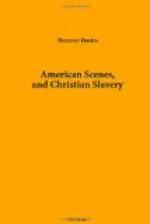On Monday morning, the 8th of February, I had a peep at the House of Representatives of the State of Louisiana, then in session at New Orleans. The room, a dark and dingy-looking place, was fitted up with desks and seats in the form of the letter D. A desk and a spittoon were allowed to each honourable member,—the latter article being deemed as necessary as the former. Whether smoking was suffered during the hours of business or not I cannot tell, but the room smelt horribly of stale tobacco. Between fifty and sixty members were present, and never certainly, either in the Old World or in the New, did I see an assemblage of worse-looking men. They seemed fitted for any deeds of robbery, blood, and death. Several distinguished duellists were pointed out to me; among them Colonel Crane, an old man, who had repeatedly fought with Mr. Bowie, the inventor of the “Bowie knife,” and had killed several men in personal combat! The motion before the house just at that time was for the release from prison of a Mr. Simms, who a few days before had violently assaulted one of the members in the lobby. He was released accordingly. Who will not pity the 200,000 slaves of this State, who are at the “tender mercies” of these sanguinary men? Nor let it be said, as it often is, that New Orleans and Louisiana are not a fair specimen of things even in the South,—that they are more French than American, &c. This is not the case. Nothing in New Orleans struck me more forcibly than its thoroughly American character. American usages, American influence, American laws, and American religion are there predominant. Things were much better for the black and coloured people when it was not so. The French treated their slaves incomparably kinder than the Americans do. They often married coloured women, and invariably treated their own coloured offspring, whether legitimate or illegitimate, with tenderness and regard. They had them suitably educated and adequately provided for; so that, at the present moment, a large portion of the city of New Orleans is the freehold property of coloured persons. Not so act the Americans. They indulge in the grossest licentiousness with coloured women, but would shudder at the idea of marrying one of them; and, instead of giving any property to their coloured offspring, they do not scruple to sell them as slaves! Had I gone to the Roman Catholic cathedral in that city, which is attended chiefly by the French and their descendants, I should have found no negro pew, but persons of all colours intermingled together in religious observances. The Southerners seem to have no heart—no feeling, except that of love to the almighty dollar.
The population of New Orleans is about 90,000. On this mass of people are brought to bear the labours of at least thirteen ministers of the Methodist Episcopal Church, seven Presbyterians, four Episcopalians, and three Baptists,—all professedly evangelical;—besides a considerable number of Roman Catholics, and other non-evangelical teachers. But Satan has there a large array of synagogues.




